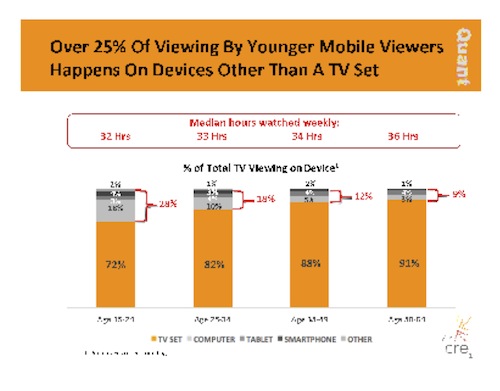MBPT Spotlight: Numbers Game--Content Still Holds the Throne. But Where are the Loyal Subjects?

More than ever, content is still king. The growing challenge, however, is figuring out how best to track the viewers of that content to mobile and other digital platforms.
There are more mobile viewers than ever, and at all age ranges. What we need to continually get a better handle on is: How and where are they watching all that content?
The Council for Research Excellence (CRE) recently released its "TV Untethered" study, conducted with the Boston-based research firm Chadwick Martin Bailey; from it, we learned more about video consumption on mobile devices (smartphones, tablets and computers), especially relative to how these devices affect and relate to viewing on a TV set.
Speaking of which, one thing the report refutes is the exasperating suggestion that "young people aren't watching TV." Pundits continue to imply this notion repeatedly, despite greater evidence that overall TV viewing is expanding. The fact is: Young people are watching more television.
A "TV Untethered" finding we had not emphasized earlier helps prove this claim.
This chart indicates our findings that even 15-to-24-year-olds are watching a hefty 32 hours (median) of TV per week—or, only four hours less than those aged 50-64. It also illustrates that they watch much differently: Among those 32 hours, 28% is spent on devices other than a TV.
A second frustration is that many still insist baby boomers are not online. This slide additionally points out that those viewers age 50-64 are transitioning to digital/mobile viewing, with 9% of their overall media consumption occurring on mobile and digital devices in the spring of 2013. I suggest that number will only grow.
Broadcasting & Cable Newsletter
The smarter way to stay on top of broadcasting and cable industry. Sign up below
What does this mean? As has always been the case in our field, content providers must follow their viewers. Now we must be sure to listen to those viewers and provide content when and where it is wanted.
It also means that advertisers and their partners must do greater research to understand their target audience. Agencies must plan with post-measurement in mind, to capture online and in-app viewing.
And it is imperative that we have a unified cross-platform metric with which to measure viewing.
A bit more about our methodology and what we've learned through "TV Untethered":
Our two-prong study encompassed nearly 6,000 participants and more than 393,000 TV viewing occasions. The initial quantitative phase monitored TV viewing on mobile devices utilizing a custom designed mobile journaling app. The second phase consisted of qualitative research exploring users' motivations and behaviors via in-home interviews in three geographically and ethnically representative markets: Atlanta, Phoenix and Kansas City.
Following the Viewer
When we first reported findings this summer, we noted a number of observations regarding viewers' use of mobile devices. For example, we found that smartphones command greater focus from the video viewer than larger viewing devices: Mobile TV viewers performed unrelated multitasking during only 14% of the occasions when they viewed TV programming on smartphones. This compared to 27% for tablet viewing, 31% for computer (desktop and laptop) viewing and 34% of the television-set viewing occasions, according to the study participants.
We also learned just how much mobile viewing actually takes place at home: 82% for both tablets and computers (laptop and PC) and 64% for smartphones. Viewers cited convenience and the ever-growing trend of self-curated multi-episode "binging."
Another fact we gleaned is that ad avoidance is not a primary motivator: 49% of participants cited "more convenient" as their top reason for viewing video on a mobile device; 13% cited "watch multiple episodes"; only 5% cited "fewer ads."
Possibly most important, we gathered further evidence of increased "TV viewing"—using the term broadly:
• Mobile devices let people watch different shows at the same time (e.g., one person watching the television, another watching separate programming on a tablet), which opens the door to a new definition of "coviewing"
• Viewing on mobile devices happens most frequently during overnight (17%) and late fringe (12%)—times of traditionally lower conventional TV HUTs. The implication is pointing toward growth in overall viewing hours.
• Mobile TV viewers participating in our survey also indicated they are heavy overall TV viewers, period.
The viewers are there. We know it. We just have to pinpoint exactly where "there" is.
The full report on the "TV Untethered" study findings can be found (under "New Research") on the Media Consumption & Engagement Committee page at the CRE website.










